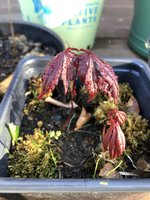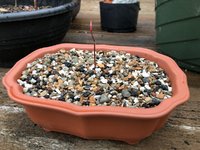bugnurd
Seedling
I’m starting individual threads for each of my trees to track their growth, development, and work. Here is my Japanese maple. Not sure if a variety can be determined, please let me know if you recognize it.
In spring of 2022, I pulled up three newly sprouted seedlings from the yard and threw them in a small pot with some garden soil. They grew a little that year, and ended up surviving the winter in the garage. Here they are in May 2023.

In spring of 2022, I pulled up three newly sprouted seedlings from the yard and threw them in a small pot with some garden soil. They grew a little that year, and ended up surviving the winter in the garage. Here they are in May 2023.





